Introduction
Johannesburg, often referred to as the “City of Gold,” is South Africa’s largest and most vibrant metropolis. Born during the late 19th-century gold rush, it has transformed into a thriving hub that blends history, culture, and modern life. Today, Johannesburg is more than just the country’s economic engine—it’s a city with a unique story to tell and countless experiences to offer.
Many international travelers view Johannesburg as merely a stopover before heading to Cape Town, Kruger National Park, or the Garden Route. However, those who pause to explore quickly discover that there are endless things to do in Johannesburg, from thought-provoking museums to buzzing art districts, bustling markets, wildlife encounters, and memorable day trips.
This guide will walk you through everything you need to know, including the best tourist attractions in Johannesburg, travel tips for first-time visitors, cultural highlights, and nearby excursions. Whether you’re traveling solo, with family, or for business, this vibrant city will surprise and inspire you.
Johannesburg Travel Guide for First-Time Visitors
If it’s your first trip to Johannesburg, the sheer size of the city can feel overwhelming. Spanning wide suburbs, downtown districts, and lively neighborhoods, it’s a place that demands some planning. This Johannesburg travel guide for first-time visitors will help you make smart choices before you even step off the plane.
Getting to Johannesburg
The city is served by OR Tambo International Airport, Africa’s busiest aviation hub, which receives daily flights from the United States, Europe, the Middle East, and Asia. Major airlines such as Delta, Emirates, Qatar Airways, and British Airways connect Johannesburg to the world.
For domestic travelers, Lanseria International Airport is another option, popular with budget airlines and regional flights.
Visa Information:
-
Citizens of the USA, UK, EU countries, Canada, and Australia can visit South Africa for up to 90 days without a visa.
-
Other nationalities may require prior approval, so it’s best to check the latest requirements before traveling.
💡 Travel Tip: Carry some local currency (South African rand – ZAR) for small purchases, though debit and credit cards are widely accepted.
Best Time to Visit Johannesburg
Johannesburg has a mild, subtropical climate with plenty of sunshine year-round, but seasons play a key role in planning your trip.
-
Summer (December–February):
-
Warm days with afternoon thunderstorms. Great for outdoor activities, but don’t forget to pack an umbrella.
-
Autumn (March–May):
-
Clear skies, mild temperatures, and colorful foliage—an ideal time to explore.
-
Winter (June–August):
-
Crisp, dry air with chilly nights. Excellent for safaris near the city.
-
Spring (September–November):
-
Famous for purple jacaranda blooms covering the streets—a breathtaking sight.
The best time to visit Johannesburg is spring or autumn, when the weather is most comfortable, and the city comes alive with festivals and outdoor events.
Where to Stay in Johannesburg
Johannesburg is spread out, so where you stay will shape your experience. Here are the main areas to consider:
-
Sandton & Rosebank (Luxury):
-
Sandton is known for upscale hotels like The Michelangelo and Hilton Sandton, with luxury shopping at Nelson Mandela Square. Rosebank is slightly more relaxed, with boutique stays and trendy restaurants.
-
Melrose & Bedfordview (Mid-Range):
-
Great options for families or business travelers. These areas balance affordability with convenience.
-
Braamfontein & Maboneng (Budget & Backpacker):
-
Best for younger travelers. You’ll find creative hostels, street art, nightlife, and a thriving café culture.
💡 Safety Tip: Choose accommodations in well-known districts, and avoid walking in unfamiliar areas after dark.
Getting Around the City
Johannesburg is vast, so planning your transport is essential.
-
Gautrain:
-
A modern, efficient rail system connecting the airport with Sandton, Rosebank, and even Pretoria. Safe and convenient.
-
Uber & Bolt:
-
Reliable, affordable, and the safest option for tourists.
-
Car Rentals:
-
Ideal if you plan to explore areas outside Johannesburg, such as the Cradle of Humankind or Pilanesberg.
-
Minibus Taxis:
-
Widely used by locals but not recommended for first-time visitors due to safety and navigation challenges.
-
Walking:
-
Only advisable in busy, safe districts like Rosebank or Sandton.
💡 Tip: Always keep your belongings secure and check local guidance before heading into new neighborhoods.
For first-time travelers, planning the essential things to do in Johannesburg ahead of time makes exploring this vast city far easier and more enjoyable.”
Best Tourist Attractions in Johannesburg
If you’re wondering about the must-see things to do in Johannesburg, start with its world-class tourist attractions that showcase history, culture, and entertainment.
Johannesburg is filled with attractions that highlight both its history and its modern identity. From moving museums to vibrant neighborhoods, the city has something for everyone. Here are some of the best tourist attractions in Johannesburg that deserve a spot on your itinerary.
Apartheid Museum
The Apartheid Museum is one of the most moving experiences and should be at the top of your list when deciding on the best things to do in Johannesburg. It documents the nation’s painful history under apartheid and its journey toward democracy. Visitors begin their experience with a symbolic entry that separates people by racial classification, setting the tone for what lies ahead.
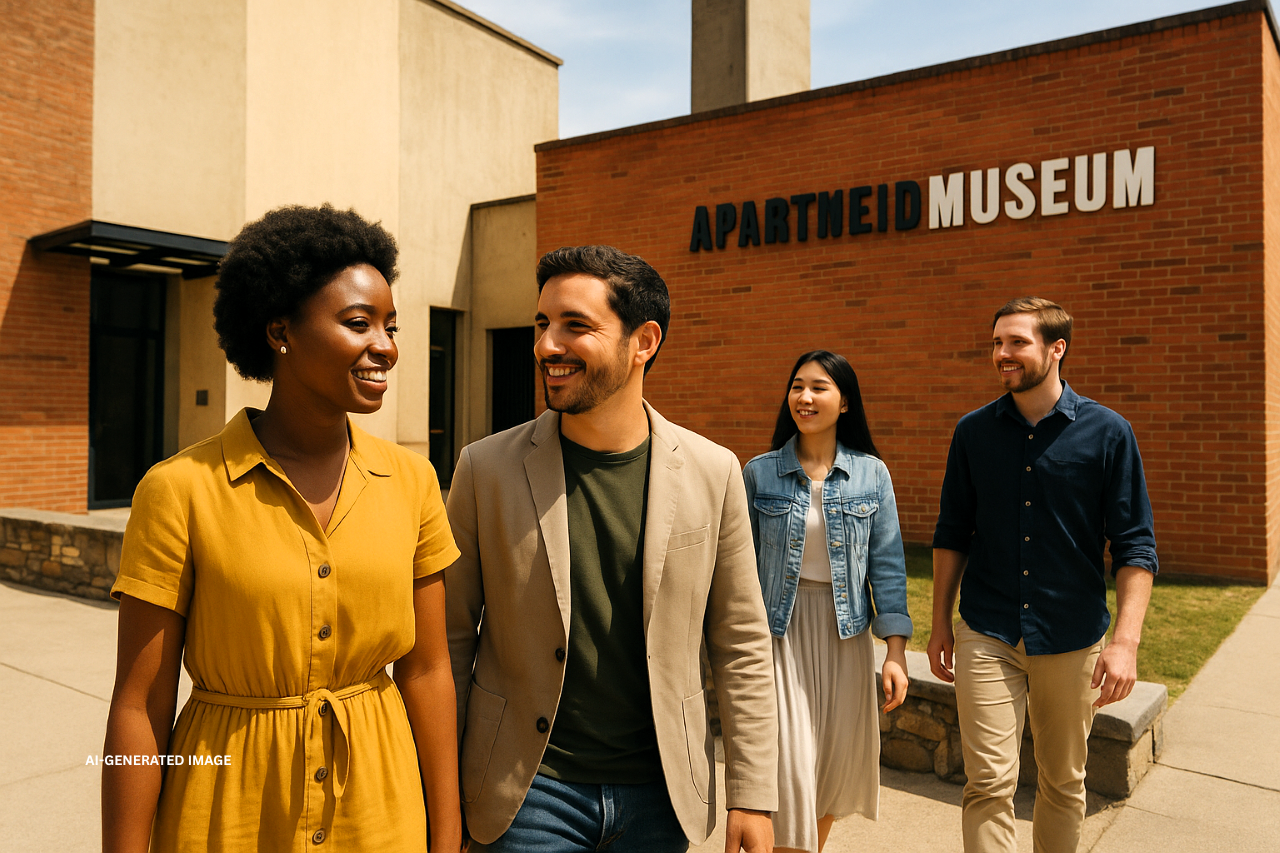
Inside, exhibits include photographs, personal stories, videos, and artifacts that give insight into life during apartheid. One of the most memorable displays is dedicated to Nelson Mandela’s role in building a democratic South Africa.
Why visit?
-
To gain a deeper understanding of South Africa’s history.
-
To engage with powerful and interactive exhibits.
💡 Tip: Allow at least two to three hours to fully explore the museum.
Constitution Hill
Constitution Hill is both a historic site and a symbol of South Africa’s democracy. Once a notorious prison, it housed political activists like Nelson Mandela and Mahatma Gandhi, along with many ordinary citizens.
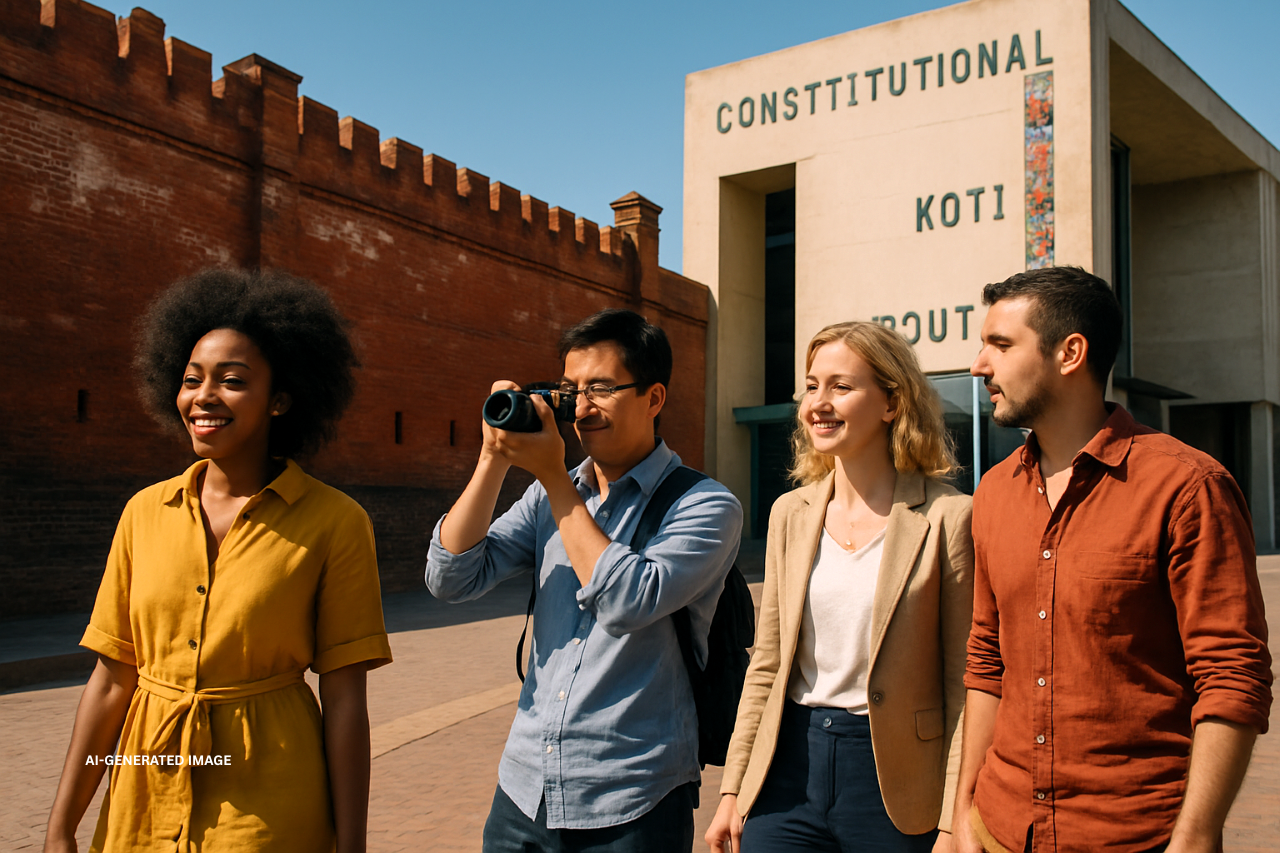
Today, it is home to the Constitutional Court of South Africa, the highest court in the country. Guided tours take visitors through the old prison cells, women’s jail, and courtroom, offering a profound perspective on the country’s journey from oppression to freedom.
Highlights:
-
Explore the site where the past and present meet.
-
Learn about the resilience and courage of South Africa’s freedom fighters.
Gold Reef City
Gold Reef City is a unique attraction that combines history with entertainment. Built on the site of a former gold mine, it offers a fascinating look at Johannesburg’s gold rush origins. Visitors can tour an underground mine, witness historical reenactments, and enjoy thrilling rides at the theme park.
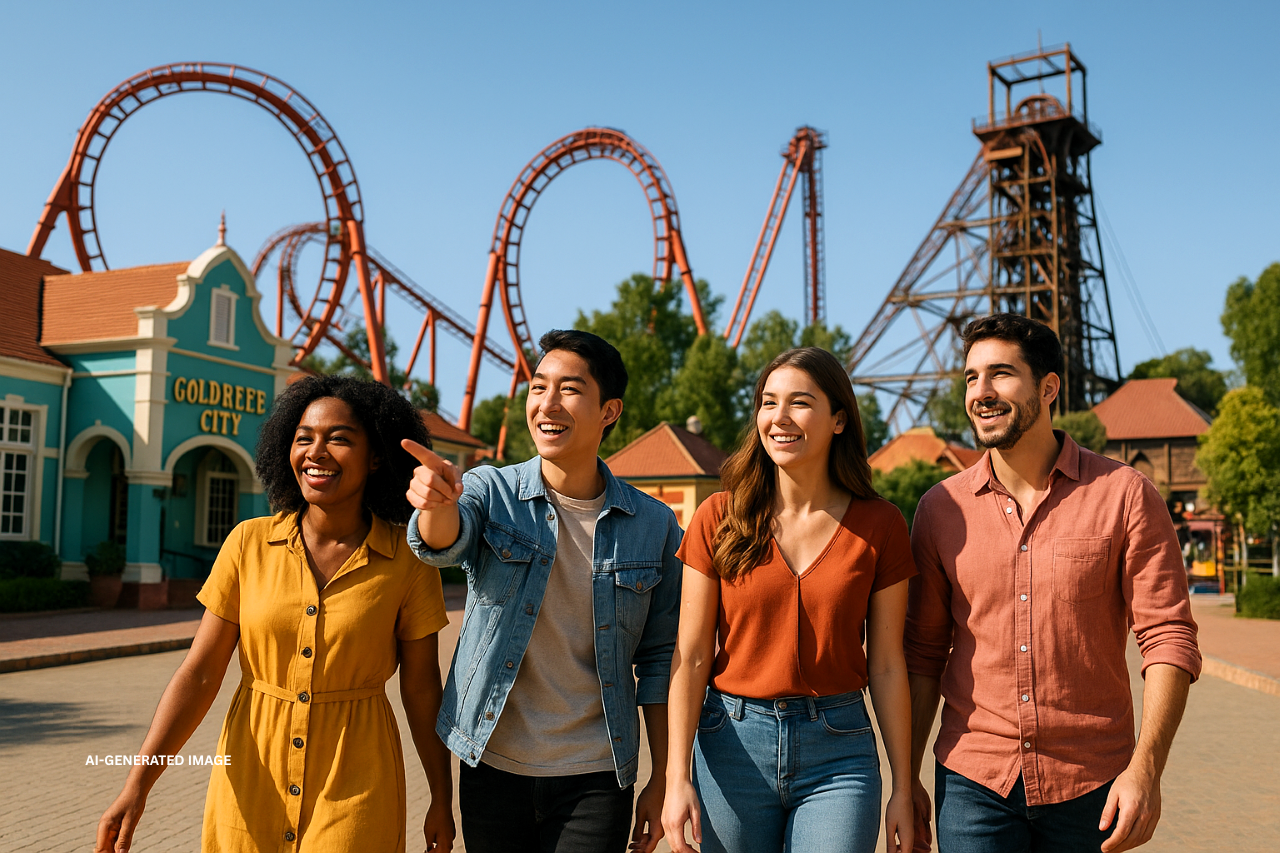
From roller coasters to family-friendly activities, Gold Reef City provides a mix of learning and fun.
Why visit?
-
To explore Johannesburg’s mining heritage.
-
To enjoy an action-packed day suitable for all ages.
Johannesburg Zoo & Botanical Gardens
The Johannesburg Zoo, established in 1904, is one of the oldest in Africa. It is home to more than 2,000 animals, including elephants, lions, and rare species like white lions and Siberian tigers. Families especially appreciate its educational and engaging environment.
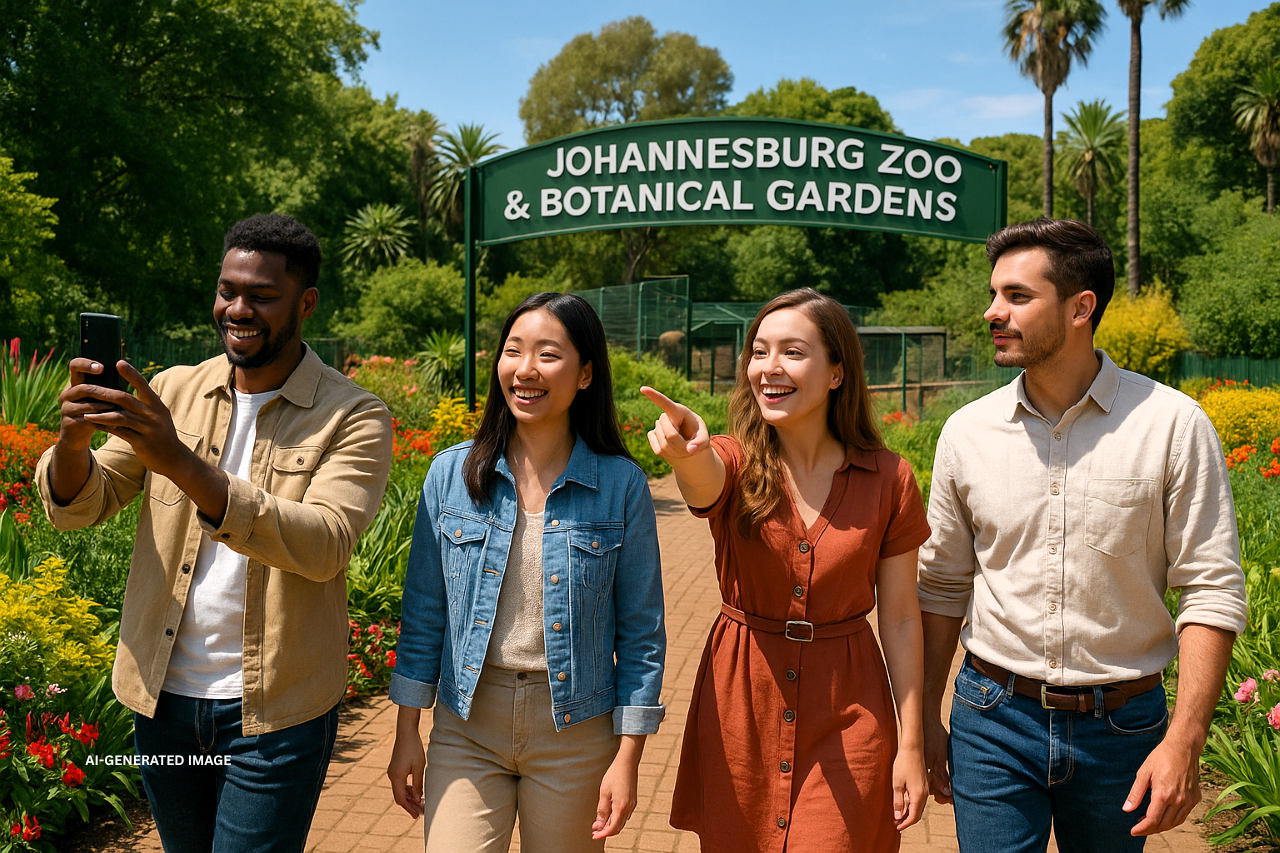
Next door, the Johannesburg Botanical Gardens offer a peaceful retreat. Covering over 80 hectares, the gardens feature themed sections such as a rose terrace and a herbarium. The nearby Emmarentia Dam is popular for picnics, boating, and birdwatching.
Maboneng Precinct
The Maboneng Precinct is one of Johannesburg’s trendiest neighborhoods. Once an industrial area, it has been transformed into a hub of creativity and culture. The streets are decorated with colorful murals and lined with art galleries, boutique shops, and lively cafés.
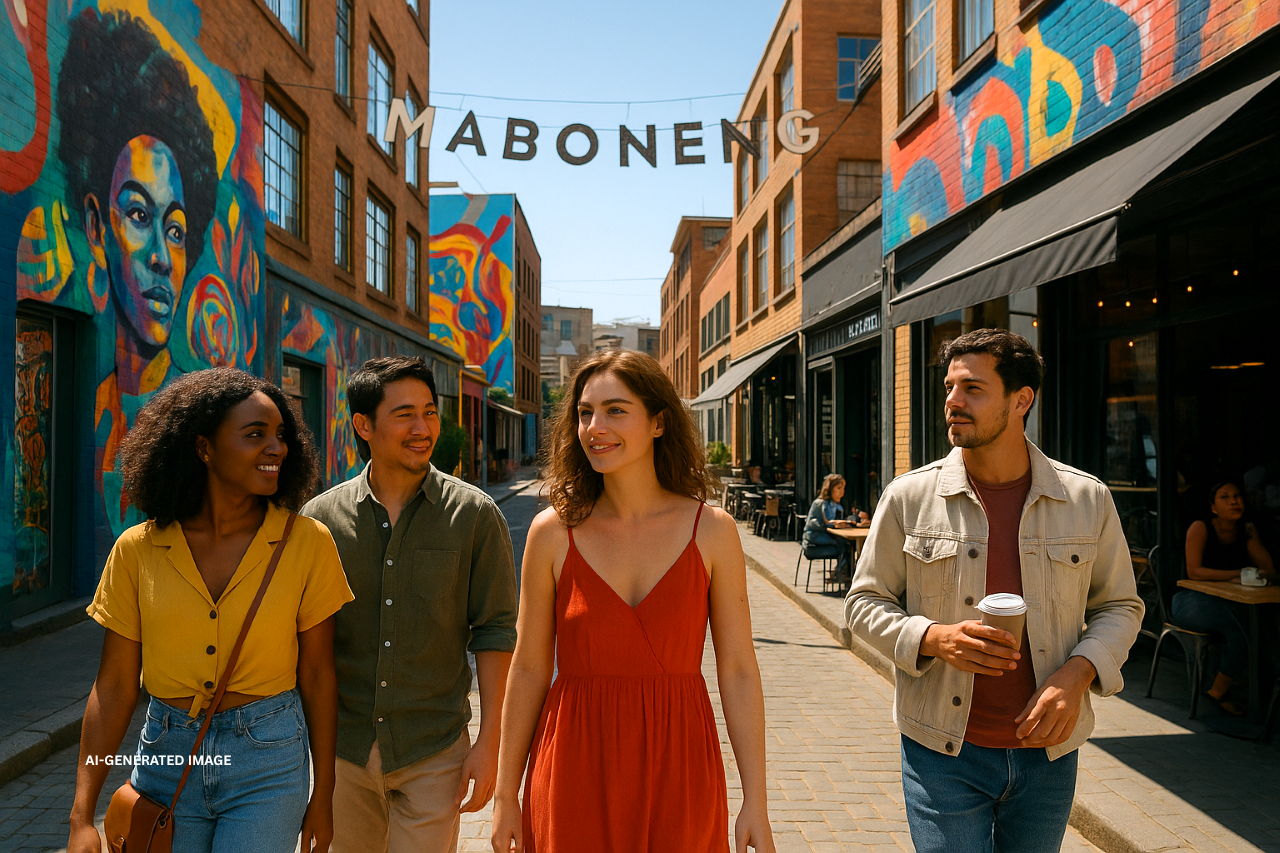
On Sundays, the Market on Main brings the precinct alive with local food, crafts, and music. It’s the perfect place to experience Johannesburg’s youthful and dynamic spirit.
Top Places to Visit in Johannesburg, South Africa
Johannesburg offers more than its most famous attractions, and there are many things to do in Johannesburg. To experience its diversity, visitors should explore beyond the city center. Here are some of the top places to visit in Johannesburg, South Africa, that highlight its culture, heritage, and natural beauty.
Soweto
Soweto (South Western Townships) is not only one of the most famous townships but also among the most meaningful things to do in Johannesburg for visitors who want to connect with history. It played a central role in the struggle against apartheid and remains a vibrant community today.
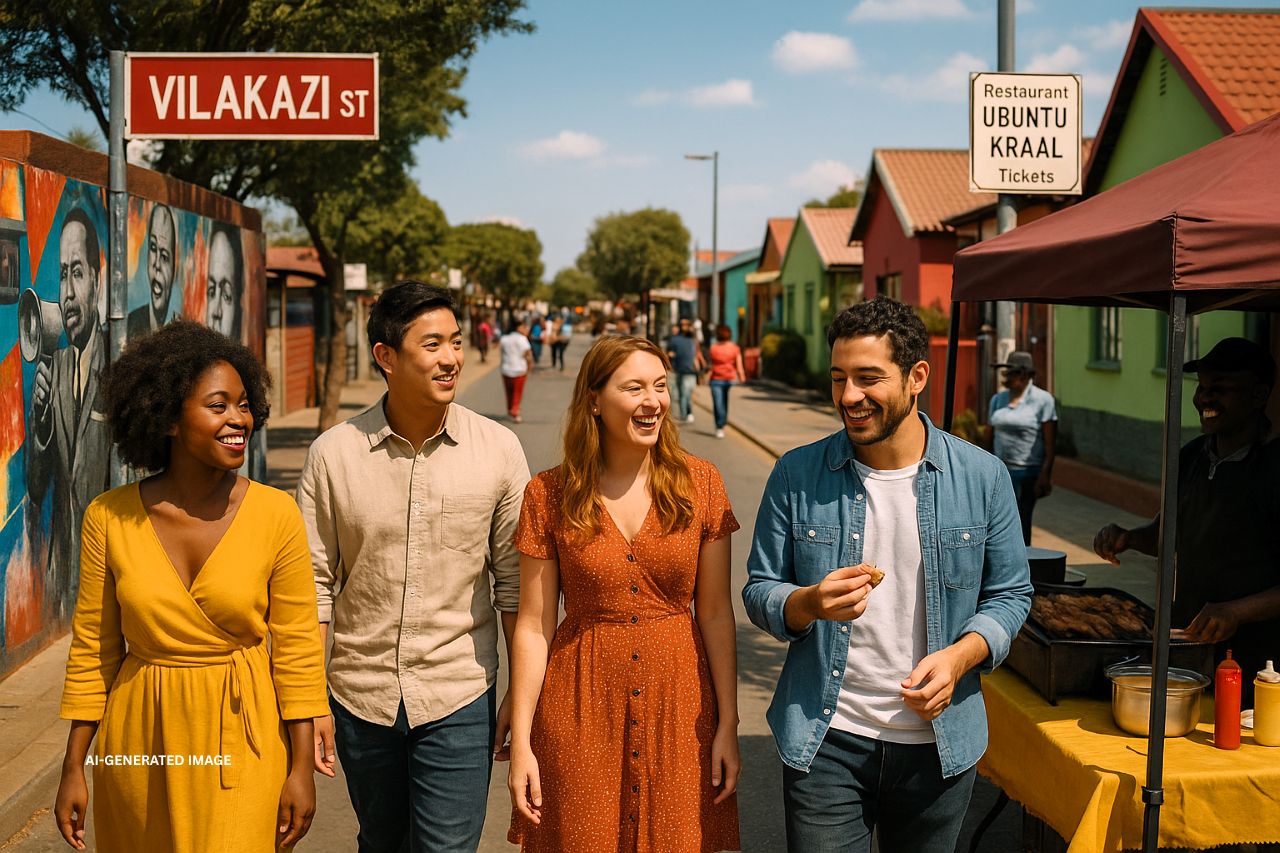
-
Vilakazi Street:
-
The only street in the world where two Nobel Peace Prize winners—Nelson Mandela and Desmond Tutu—once lived. Mandela’s former house is now a museum.
-
Hector Pieterson Memorial:
-
A solemn tribute to the students who lost their lives during the 1976 Soweto Uprising.
-
Local Food:
-
Try shisa nyama (grilled meat) and traditional stews at township restaurants for an authentic taste of Soweto.
The Cradle of Humankind (UNESCO World Heritage Site)
About an hour from Johannesburg, the Cradle of Humankind is one of the world’s most important archaeological sites. It provides insight into the origins of humankind.
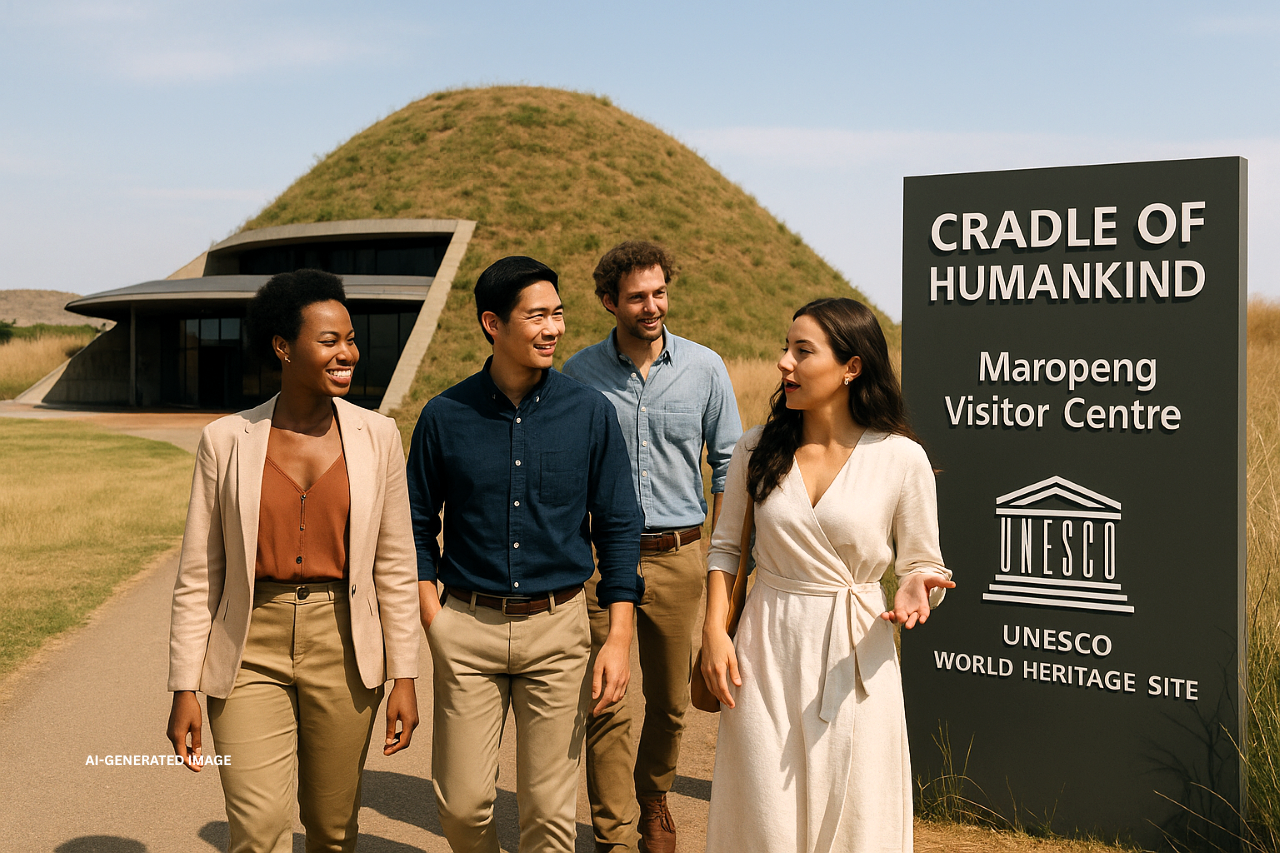
-
Maropeng Visitor Centre:
-
Features interactive exhibits that explain human evolution.
-
Sterkfontein Caves:
-
Known for groundbreaking fossil discoveries, including some of the earliest hominid remains.
This UNESCO World Heritage Site is a must for history and science enthusiasts.
Sandton City & Nelson Mandela Square
Sandton is Johannesburg’s financial district and one of the wealthiest areas in Africa.
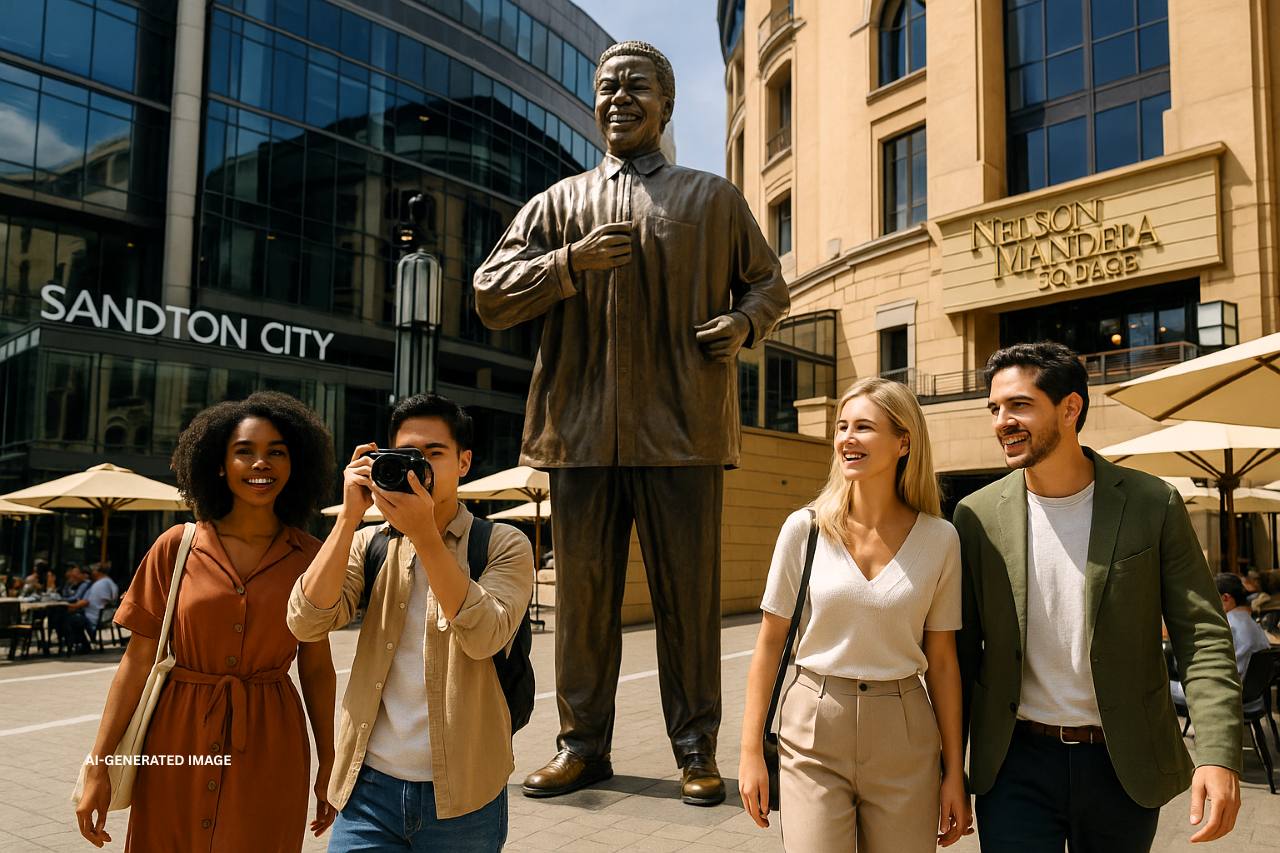
-
Sandton City Mall:
-
A vast shopping destination with international luxury brands, local designers, and gourmet dining.
-
Nelson Mandela Square:
-
Adjacent to the mall, the square is home to a six-meter bronze statue of Mandela, making it a popular spot for photos.
Johannesburg Art Gallery & Market on Main
Art lovers will appreciate the Johannesburg Art Gallery (JAG), which houses an impressive collection of both local and international art. Works range from classical European paintings to contemporary African pieces.

For a more interactive cultural experience, the Market on Main in Maboneng is a vibrant Sunday market featuring handmade crafts, design products, and delicious street food. It’s an excellent place to shop for souvenirs while supporting local artists.
Lion & Safari Park
For those who want a taste of South Africa’s wildlife without venturing too far, the Lion & Safari Park is a great option. Located just outside Johannesburg, it is home to lions, cheetahs, giraffes, and zebras. Visitors can enjoy guided game drives or self-drive tours for close encounters with animals.
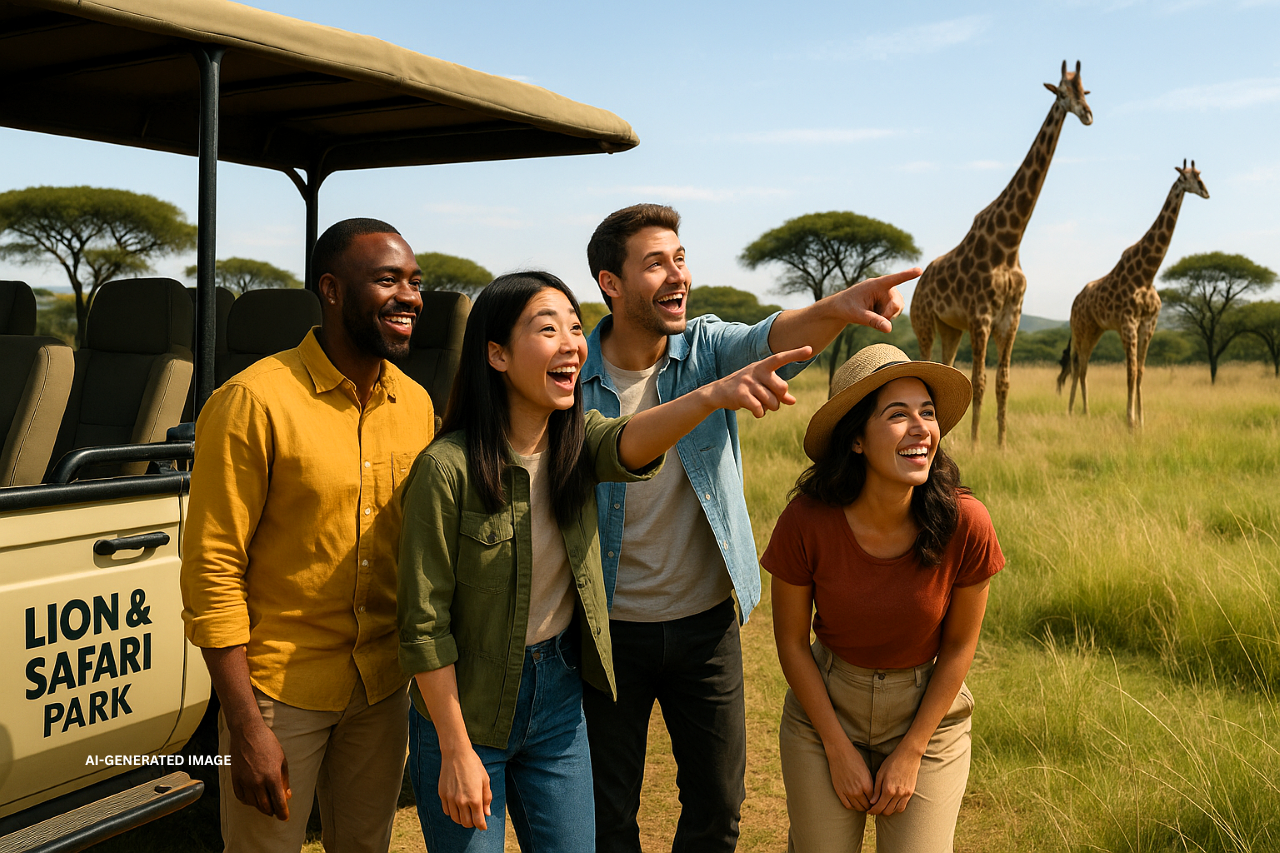
💡 Tip: Visit early in the morning or late in the afternoon when animals are most active.
Unique Cultural Experiences in Johannesburg
Johannesburg is often called the heartbeat of South Africa because of its cultural richness and energy. Beyond its well-known landmarks, the city offers unique experiences that let travelers immerse themselves in local traditions, flavors, and creativity. Exploring local cuisine, music, and markets is one of the most rewarding things to do in Johannesburg, as it connects visitors directly with the city’s culture.”
Traditional Food & Cuisine
Food is one of the most authentic ways to connect with Johannesburg. The city’s cuisine reflects its multicultural identity, blending African, Indian, and European influences.
-
Bunny Chow:
-
A hollowed-out loaf of bread filled with spicy curry, originally from Durban but now popular in Johannesburg.
-
Pap & Chakalaka:
-
A staple dish made of maize porridge (pap) paired with chakalaka, a spicy vegetable relish.
-
Braai (South African Barbecue):
-
A beloved tradition where families and friends gather around a grill to enjoy meats such as beef, lamb, chicken, and boerewors (farmers’ sausage).
-
Food Markets:
-
The Neighbourgoods Market in Braamfontein is perfect for sampling artisanal food and international flavors in a lively atmosphere.
Food tours are also available for visitors who want to explore the city’s culinary culture with local guides.
Music and Dance
Johannesburg has always been a center for music and performance in South Africa. The city is famous for jazz, kwaito, and house music, making it a great destination for music lovers.
-
Jazz Venues:
-
Johannesburg has a long-standing jazz tradition, with small clubs and theaters hosting live performances.
-
Kwaito:
-
Emerging in the 1990s, this genre combines house beats with African languages and rhythms. It remains one of the most popular styles of music in the city.
-
Dance:
-
From traditional Zulu and Sotho performances to contemporary Afro-fusion, cultural dances are performed at festivals and theaters across the city.
Local Markets and the Art Scene
Markets and art spaces are some of the best places to feel Johannesburg’s creativity.
-
Neighbourgoods Market:
-
A bustling Saturday market filled with food vendors, craft stalls, and live entertainment.
-
Rosebank Art & Craft Market:
-
A hotspot for African souvenirs such as beadwork, wooden carvings, and textiles.
-
Maboneng Precinct:
-
Famous for its colorful murals and small art galleries, it represents the city’s modern, youthful spirit.
Exploring these spaces allows visitors to meet artists, shop for authentic items, and experience Johannesburg’s creative energy.
Johannesburg Nightlife and Entertainment Spots
When the sun sets, Johannesburg comes alive. The nightlife scene is diverse, ranging from elegant rooftop bars to energetic clubs and theaters. Exploring the nightlife is one of the liveliest things to do in Johannesburg, whether you prefer rooftop cocktails, jazz clubs, or energetic dance floors.
Trendy Bars & Rooftop Lounges
Rooftop venues are especially popular for their views and relaxed vibe.
-
Living Room (Maboneng):
-
A rooftop garden space with panoramic city views.
-
San Deck (Sandton):
-
A stylish lounge offering cocktails and views of Nelson Mandela Square.
-
Marabi Club:
-
A unique combination of fine dining and live jazz, with an atmosphere inspired by the 1920s.
Clubs & Live Music Venues
Johannesburg also has a thriving clubbing culture for those who want to dance the night away.
-
Truth (Midrand):
-
A legendary electronic music club housed in an industrial building.
-
Great Dane (Braamfontein):
-
Known for its quirky décor and eclectic playlists, it is popular among students and young professionals.
-
Bassline:
-
A long-standing venue for live African and international performances.
Theatre and Performing Arts
For a different kind of evening, Johannesburg offers an exciting theater scene.
-
Market Theatre:
-
Famous for staging plays that challenged apartheid, it continues to produce socially conscious performances.
-
Joburg Theatre:
-
Hosts musicals, ballet, opera, and large-scale productions.
-
POPArt Theatre:
-
A smaller venue dedicated to experimental works and emerging talent.
Whether you’re into drama, comedy, or live music, the performing arts add another layer to Johannesburg’s cultural life.
Family-Friendly Activities in Johannesburg
Johannesburg is not just for adults—it also caters to families with plenty of fun and educational attractions. For families, some of the most enjoyable things to do in Johannesburg include visiting the zoo, exploring science centers, and spending a day at Gold Reef City.”
Johannesburg Zoo & Montecasino Bird Gardens
-
Johannesburg Zoo:
-
Established in 1904, the zoo is home to over 2,000 animals, including lions, elephants, and rare species. It’s a great place for children to learn about conservation.
-
Montecasino Bird Gardens:
-
Located in Fourways, this park features exotic birds, reptiles, and small animals. The bird show is especially popular with families.
Sci-Bono Discovery Centre
The Sci-Bono Discovery Centre in Newtown is one of Africa’s largest science museums. It features hundreds of interactive exhibits on science, technology, and space, making it both fun and educational for children.
Family Adventure Parks
Johannesburg has several outdoor spaces and adventure parks that are ideal for families.
-
Delta Park:
-
A green space with cycling paths, playgrounds, and picnic areas.
-
Cedar Square Adventure Golf:
-
A fun mini-golf venue where families can spend quality time together.
-
Gold Reef City Theme Park:
-
Combines thrilling rides with historical mining exhibits, making it entertaining for all ages.
Why Families Love Johannesburg
-
A variety of safe, family-oriented attractions.
-
Activities that combine fun with learning opportunities.
-
Accommodation and dining options suitable for parents and children alike.
Day Trips and Excursions from Johannesburg
Johannesburg is ideally located for travelers who want to explore beyond the city. Within just a few hours’ drive, you can find historic sites, mountain escapes, and wildlife reserves. There are many things to do in Johannesburg. These day trips from Johannesburg will add even more depth to your journey.
Pretoria – The Jacaranda City
Less than an hour away, Pretoria is South Africa’s administrative capital. Its streets burst into purple during spring when jacaranda trees bloom, creating a striking display.
-
Union Buildings:
-
The seat of the government is surrounded by beautifully landscaped gardens.
-
Voortrekker Monument:
-
A granite landmark commemorating early pioneers.
-
Freedom Park:
-
A memorial dedicated to those who contributed to South Africa’s freedom.
Pilanesberg National Park
About 2.5 hours from Johannesburg, Pilanesberg National Park is a popular choice for wildlife enthusiasts. Situated in an ancient volcanic crater, the park is home to the Big Five (lion, leopard, elephant, buffalo, and rhino).
Visitors can join guided game drives or explore on their own. Early morning and late afternoon are the best times to see animals in action.
Sun City Resort
Next to Pilanesberg lies the famous Sun City Resort, often compared to a mini Las Vegas. It’s known for its entertainment and leisure facilities.
-
Valley of Waves:
-
A waterpark with artificial waves and sandy beaches.
-
Casinos and Live Shows:
-
Entertainment options for adults.
-
Golf Courses:
-
Championship courses designed by golfing legends.
Magaliesberg Mountains
Just 90 minutes from Johannesburg, the Magaliesberg Mountains provide a peaceful getaway.
-
Activities:
-
Hiking, canopy tours, and rock climbing.
-
Special Experience:
-
Hot-air balloon rides at sunrise, offering spectacular views.
Hartbeespoort Dam
Known locally as “Harties,” Hartbeespoort Dam is a popular weekend retreat.
-
Harties Cableway:
-
Offers panoramic views of the dam and mountains.
-
Adventure Sports:
-
Jet skiing, boating, and parasailing are widely available.
-
Markets and Dining:
-
Local craft stalls and lakeside restaurants complete the experience.
Adding day trips to places like Pilanesberg or Hartbeespoort is a great way to expand your list of things to do in Johannesburg and beyond.
Practical Travel Tips for Tourists
When planning your trip, knowing the essential things to do in Johannesburg will help you save time and enjoy the city to the fullest. Johannesburg is a rewarding destination, but first-time visitors should plan carefully. These tips will help you enjoy your trip with confidence.
Safety and Precautions
Like any major city, Johannesburg requires awareness.
-
Use trusted transportation options like Uber or the Gautrain.
-
Avoid isolated or poorly lit areas at night.
-
Keep valuables out of sight and avoid wearing flashy jewelry.
Budgeting for Your Trip
-
Accommodation:
-
Budget hostels start at around $20–40 per night, while luxury hotels can exceed $150.
-
Food:
-
Meals range from $10 at local eateries to $30+ at high-end restaurants.
-
Attractions:
-
Museums and galleries usually cost under $10, while safaris and day tours range from $100 to $200.
Cultural Etiquette
-
A warm greeting is always appreciated.
-
Learning a few words in Zulu, Sesotho, or Afrikaans will make a good impression.
-
Tipping is expected—10–15% in restaurants and small amounts for drivers, porters, and guides.
Conclusion
Johannesburg is often overlooked, but it has so much to offer those who take the time to explore. It’s a city of contrasts—historic and modern, energetic yet relaxed—and each neighborhood tells its own story.
From profound sites like the Apartheid Museum and Constitution Hill to the colorful streets of Maboneng, Johannesburg blends history with creativity. Add in its lively food culture, nightlife, family-friendly attractions, and nearby excursions, and you’ll find no shortage of things to do in Johannesburg.
For travelers looking for a destination that combines culture, history, and adventure, Johannesburg is a city that surprises, challenges, and inspires. With its mix of history, culture, and adventure, there are endless things to do in Johannesburg, making it a city that every traveler should explore.
FAQs
Is Johannesburg safe for tourists?
Yes, if you follow basic precautions. Stick to safe neighborhoods, use reliable transport, and avoid walking alone at night.
What is Johannesburg famous for?
It is known as the “City of Gold,” the heart of South Africa’s mining industry, and a hub for culture and business.
How many days should I spend in Johannesburg?
Three to four days are ideal for exploring the city and adding a day trip or two.
What are the best day trips from Johannesburg?
Pretoria, Pilanesberg National Park, Sun City, Magaliesberg Mountains, and Hartbeespoort Dam.
Is Johannesburg expensive to visit?
It can be budget-friendly. Accommodation and food suit all budgets, while luxury tours and safaris can raise costs.
When is the best time to visit Johannesburg?
Spring (September–November) and autumn (March–May) offer pleasant weather and lively city events.
Can I go on a safari near Johannesburg?
Yes, Pilanesberg National Park and the Lion & Safari Park are excellent options nearby.
Where can I buy souvenirs in Johannesburg?
The Rosebank Art & Craft Market, Market on Main, and township markets are great places to shop.
